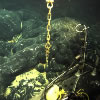News archives:
2015
 Axial Seamount Eruption Forecast
Axial Seamount Eruption Forecast
An eruption is forecast to occur at Axial Seamount by the end of 2015, based on measurements of uplift of the seafloor in the summit caldera since the 2011 eruption. Axial Seamount is the most active submarine volcano in the NE Pacific and the site of the new OOI/RSN cabled observatory. Follow the eruption forecast on our new Axial Blog.
2014
An expedition on the NOAA ship Hi’ialakai, May 11-20, 2014, was focused on Maug island in the northern Marianas, which is a flooded caldera where volcanic CO2 vents directly into a shallow coral reef ecosystem. Preliminary results show that gradients in pH are created around the CO2 vents and they have a strong impact on the health and distribution of coral species around the vents Read more here.
2013
 Axial Seamount is re-inflating
Axial Seamount is re-inflating
PMEL scientists on a September 2013 expedition to Axial Seamount documented that the center of the volcano’s caldera has reinflated over 1.5 meters (>5 feet) since its last eruption in April 2011, more than was expected. This means that the volcano has already recovered 65% of the -2.4 meters that it deflated in 2011, and that it could be ready to erupt again within just a few more years, if this rate of inflation continues. Read more here.
Precursors to Eruption at Axial Seamount Found
NOAA PMEL scientists recently published papers in the journal Nature Geoscience that show, for the first time, that precursory signals were recorded by seafloor instruments before an undersea volcanic eruption at Axial Seamount in 2011. The work was jointly funded by NOAA, the National Science Foundation, and the Monterey Bay Aquarium Research Institute. Such signals could be used to issue long-term and short-term forecasts of future eruptions at the site. Oregon State University Press Release. Read more here.
2012
 Exploration of new hydrothermal systems in the NE Lau Basin
Exploration of new hydrothermal systems in the NE Lau Basin
This expedition used the MARUM QUEST 4000 remotely operated vehicle (ROV) to conduct seafloor investigations at multiple sites on the northernmost spreading centers, magmatic arc and backarc regions of the northern Lau basin. The nine sites explored on the 12 dives with QUEST 4000 discovered many new submarine hot springs, underwater fumaroles and several new species of chemosynthetic fauna. Visit the expedition web sitehere. More information available here.
"Bloop" sound is an icequake: Wired UK reports on the recent NOAA Acoustics Program website's information update regarding the Bloop sound.
11/30/2012
2011
 Eruption discovered at Axial Seamount
Eruption discovered at Axial Seamount
NOAA EOI Program scientists discovered a newly erupted lava flow at Axial Seamount, an active submarine volcano on the Juan de Fuca Ridge located about 250 miles off the coast of Oregon. Axial Seamount has been the site of NOAA’s New Millennium Observatory (NeMO) seafloor observatory for the past 14 years and it is the site of a future cabled observatory as part of the National Science Foundation’s Ocean Observatory Initiative (OOI). Oregon State University Press Release. More information available here.
2010
 Expedition to NW Rota-1 Volcano
Expedition to NW Rota-1 Volcano
This expedition discovered that NW Rota-1 had experienced a major landslide since it was last visited in 2009. This major event destroyed pre-existing habitat for the chemosynthetic biological communities at the hydrothermal vents, but affected different species in different ways. Visit the expedition web site here. More information available here.
2009
Discovery of NE Lau Basin eruptions 
PMEL scientists discovered two active eruptions in the NE Lau Basin, one at the NE Lau spreading center and the other at West Mata Volcano. Later a “rapid response” expedition returned to the two eruption sites with ROV Jason and witnessed spectacular eruptions continuing at West Mata Volcano. View NOAA Press Release, and video of West Mata erupting onYouTube. More information available here.
Other news items:
Scientists Discover and Image Explosive Deep-Ocean Volcano
NOAA News 12/17/2009 NOAA News
Right Whales not Extinct
NOAA News 5/20/2009
 Previously unknown fault caused earthquake swarm off Oregon's coast
Previously unknown fault caused earthquake swarm off Oregon's coast
OregonLive
Researchers Explain Recent Coastal Earthquake Swarms
Oregon Public Broadcasting10/26/09
NOAA Expedition Hears Endangered North Atlantic Right Whales off Greenland
NOAA News 5/20/2009
NW Rota-1 Eruption/Expedition
National Science Foundation Press Release
(5/6/2009)
Global compilation of hydrothermal vent locations
(4/28/2009)
2008
Underwater Volcano Eruption Caught on Camera
Discovery Channel
6/12/2008
Earthquake swarm at North Gorda
(4/23/2008)
Oregon Offshore Earthquakes
600+ quakes in 10 days (4/14/2008)
Antarctic Research
OPB Oregon Field Guide 2/12/2008
Listen
to climate change
(Oregonian 1/6/08)
2006
Long-term eruptive activity at a submarine arc volcano
Nature (5/24/06)
Video Captures Underwater 'Brimstone and Fire'
NPR All Things Considered (5/24/06)
Explorers Discover Undersea Volcano's Long-term Eruption
NOAA Press Release
Science Daily 4/17/06

